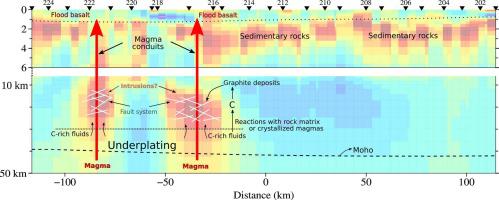当前位置:
X-MOL 学术
›
Phys. Earth Planet. Inter.
›
论文详情
Our official English website, www.x-mol.net, welcomes your feedback! (Note: you will need to create a separate account there.)
Magmatic underplating, plumbing system, and carbon-enhanced electrical conductivity in the Paraná Magmatic Province
Physics of the Earth and Planetary Interiors ( IF 2.3 ) Pub Date : 2024-03-31 , DOI: 10.1016/j.pepi.2024.107185 Gabriel Negrucci Dragone , Mauricio de Souza Bologna
Physics of the Earth and Planetary Interiors ( IF 2.3 ) Pub Date : 2024-03-31 , DOI: 10.1016/j.pepi.2024.107185 Gabriel Negrucci Dragone , Mauricio de Souza Bologna

|
The origin of large igneous provinces (LIPs) is still an enigma but likely involves magma storage and pathways spread throughout the crust, requiring indirect methods for its study. Here, we present 3-D resistivity models derived from the inversion of broadband (∼0.0001–3000 s) magnetotelluric data with 9–13 km lateral spacing in the central Paraná Magmatic Province, an expressive Early Cretaceous LIP in South America. Our results map in greater detail the previously interpreted LIP magma conduit and support, in contrast with seismological models, significant magmatic underplating to explain the observed conductivity near the LIP central axis. The potential axial lava feeder appears as a pair of crustal conductors (5–15 km; >0.1 S/m) parallel to the region of maximum thickness of both pre-volcanic sedimentary rocks and erupted tholeiitic basalts along an extension of at least 800 km. We propose the high conductivity is due to graphite films of precipitated carbon during the ascension of carbon-bearing fluids released by crystallizing magmas underplated at the base of the crust. The association of high conductivity with underplating is supported by high Vp/Vs ratios close to the conductive lineament, by a lower-crustal zone of high P-wave velocities at the basin axis attributed to mafic intrusions, and by a residual gravity high interpreted as gabbros underplated/intruded in the lower crust. Moreover, the conductive lineament is spatially associated with intracrustal high densities inferred from geoid inversion and upper-crustal high P-wave velocities. Early CO release during crystallization of underplated magma before eruption could explain the time gap between the Weissert ocean anoxic event and the volcanism. Our study advances in the controversial topic of magmatic intrusive components in the Paraná LIP with implications for LIP generation and paleo-climate studies.
中文翻译:

巴拉那岩浆省的岩浆底侵、管道系统和碳增强导电性
大火成岩省(LIP)的起源仍然是一个谜,但可能涉及岩浆储存和遍布地壳的路径,需要间接方法进行研究。在这里,我们提出了从巴拉那岩浆省中部横向间距为 9-13 km 的宽带(∼0.0001-3000 s)大地电磁数据反演得出的 3-D 电阻率模型,巴拉那岩浆省是南美洲一个富有表现力的早白垩世 LIP。我们的结果更详细地绘制了先前解释的 LIP 岩浆通道和支撑,与地震模型相比,显着的岩浆底侵解释了 LIP 中心轴附近观察到的电导率。潜在的轴向熔岩馈源表现为一对地壳导体(5-15 km;>0.1 S/m),平行于火山前沉积岩和喷发拉斑玄武岩的最大厚度区域,沿至少 800 km 的延伸。我们认为高电导率是由于地壳底部结晶岩浆释放的含碳流体上升期间沉淀碳的石墨膜所致。高电导率与底侵的关联受到以下因素的支持:接近导电线层的高 Vp/Vs 比、由于镁铁质侵入而导致盆地轴处的高 P 波速度的下地壳区域以及解释为的残余重力高辉长岩欠镀/侵入下地壳。此外,导电线在空间上与大地水准面反演和上地壳高纵波速度推断出的地壳内高密度相关。喷发前盘底岩浆结晶过程中早期二氧化碳的释放可以解释韦瑟特海洋缺氧事件和火山活动之间的时间差距。我们的研究在巴拉那 LIP 中岩浆侵入成分这一有争议的话题上取得了进展,对 LIP 的生成和古气候研究具有重要意义。
更新日期:2024-03-31
中文翻译:

巴拉那岩浆省的岩浆底侵、管道系统和碳增强导电性
大火成岩省(LIP)的起源仍然是一个谜,但可能涉及岩浆储存和遍布地壳的路径,需要间接方法进行研究。在这里,我们提出了从巴拉那岩浆省中部横向间距为 9-13 km 的宽带(∼0.0001-3000 s)大地电磁数据反演得出的 3-D 电阻率模型,巴拉那岩浆省是南美洲一个富有表现力的早白垩世 LIP。我们的结果更详细地绘制了先前解释的 LIP 岩浆通道和支撑,与地震模型相比,显着的岩浆底侵解释了 LIP 中心轴附近观察到的电导率。潜在的轴向熔岩馈源表现为一对地壳导体(5-15 km;>0.1 S/m),平行于火山前沉积岩和喷发拉斑玄武岩的最大厚度区域,沿至少 800 km 的延伸。我们认为高电导率是由于地壳底部结晶岩浆释放的含碳流体上升期间沉淀碳的石墨膜所致。高电导率与底侵的关联受到以下因素的支持:接近导电线层的高 Vp/Vs 比、由于镁铁质侵入而导致盆地轴处的高 P 波速度的下地壳区域以及解释为的残余重力高辉长岩欠镀/侵入下地壳。此外,导电线在空间上与大地水准面反演和上地壳高纵波速度推断出的地壳内高密度相关。喷发前盘底岩浆结晶过程中早期二氧化碳的释放可以解释韦瑟特海洋缺氧事件和火山活动之间的时间差距。我们的研究在巴拉那 LIP 中岩浆侵入成分这一有争议的话题上取得了进展,对 LIP 的生成和古气候研究具有重要意义。



























 京公网安备 11010802027423号
京公网安备 11010802027423号